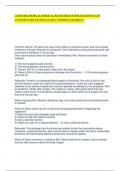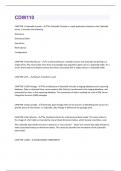CERTIFIED MEDICAL-SURGICAL REGISTERED NURSE QUESTIONS AND
ANSWERS WITH RATIONALE 100% VERIFIED | GRADED A+
Christine Warren, 45 years old, has a long history of ulcerative colitis, and non-surgical
treatment no longer relieved her symptoms. She underwent a total proctocolectomy and
a permanent ileostomy 12 hours ago.
The nurse should contact the physician immediately if Mrs. Warren has which of these
findings?
1) The stoma appears pale and dry.
2) The stoma appears red and shiny.
3) There is 200 mL of dark green output from the stoma.
4) There is 50 mL of serosanguinous drainage from the stoma. - 1) The stoma appears
pale and dry.
Rationale: If there is an adequate blood supply to the stoma, the color is pink or red,
and the stoma is moist as a result of mucous production. A pale dry color suggests
ischemia of the stoma or bowel and must be reported immediately to the physician. With
an ileostomy initially after surgery, the output is a loose, dark green liquid that may
contain some blood. The ileostomy usually begins to drain within 24 of surgery at more
than one liter per day.
When changing Mrs. Warren's ileostomy bag, the nurse notices that the peristomal skin
is irritated.
Which of these actions by the nurse would be appropriate before reapplying the
appliance?
1) Wash the area with antiseptic soap and water.
2) Clean the site with Dakin's solution.
3) Use a solid skin barrier.
4) Obtain an order for a topical antibiotic. - 3) Use a solid skin barrier.
Rationale: The drainage from the stoma can quickly irritate the surrounding tissue.
Therefore, a solid skin barrier, with a pectin base or karaya wafer that has a measurable
thickness and hydrocolloid adhesive properties, should be applied.
Which of these comments, if made by Mrs. Warren before her surgery, would indicate
that she had concerns about her body image?
,1) "I will have to stop my aerobics classes."
2) "I'm so afraid I may not survive the surgery."
3) "I need to go shopping for some loose, baggy clothes."
4) "I'm concerned that this may be only the first of many surgeries." - 3) "I need to go
shopping for some loose, baggy clothes."
Rationale:Body image refers to a person's perception of self and determines how the
person interacts with others. One does not need to purchase special clothing after
ileostomy surgery, although some minor adjustments may be needed for comfort, e.g.,
stretch underwear or pantyhose for support.
Lewis Palmer, 45 years old, has a history of multiple myocardial infarctions and is a
heavy smoker. He takes warfarin sodium (Coumadin) daily. Two weeks ago, he had a
right femoral-popliteal bypass, which became occluded 24 hours ago. He is admitted
following an angioplasty of the femoral-popliteal bypass graft. Mr. Palmer is receiving
continuous IV heparin.
Because Mr. Palmer is receiving heparin, it is essential for the nurse to
1) monitor his prothrombin time.
2) observe him for signs of pulmonary embolism.
3) limit his intake of foods high in vitamin K.
4) check the femoral puncture site at frequent intervals. - 4) check the femoral puncture
site at frequent intervals.
Rationale: Since bleeding is a common side effect of heparin, it is vital to check the
operative site, the femoral puncture area, for signs of bleeding.
Attempts to revascularize Mr. Palmer's leg are unsuccessful, and Mr. Palmer has a
below-knee amputation (BKA) of his right extremity and is returned to the medical-
surgical unit with an intravenous infusion in place. His orders include: heparin drip,
morphine sulfate 10 mg IV push q4h prn for pain, and ampicillin sodium g 1 IV q6h.
Twelve hours postoperatively, Mr. Palmer is found to be short of breath and diaphoretic.
He says, "My chest hurts." His pulse is 140/min, compared to a baseline of 80/min. His
blood pressure is105/60 mm Hg, compared to a baseline of 138/70 mm Hg. His
respirations are 32/min, compared to a baseline of 16/min. His O2 saturation is 85%.
The nurse immediately calls for help. Which of the following questions is most important
for the nurse to ask?
1) "Have you ever had this type of chest pain before?"
2) "How long have you had this pain?"
3) "What pain medication do you usually take?"
4) "What - 1) "Have you ever had this type of chest pain before?"
Rationale: Because of the patient's symptoms and his history of myocardial infarctions,
the nurse should find out if the patient has had this time of pain previously.
The nurse receives all of the following stat orders for Mr. Palmer. Which one should the
nurse question?
,1) Oxygen per nasal cannula at 4 L per minute.
2) Enoxaparin (Lovenox) 40 mg subcutaneously.
3) Troponin level.
4) Computed tomography (CT) angiogram. - Rationale: The nurse should questions the
order for Lovenox because the patient is receiving a heparin drip.
Maggie Clark, a 42-year-old female, was admitted with newly diagnosed type 2 diabetes
mellitus. Her blood glucose has been stabilized, and the nurse is preparing her for
discharge. Her discharge orders will include metformin (Glucophage). Mrs. Clark is also
being treated for hypertension.
Because Mrs. Clark is to take Glucophage on a regular basis it is important to
1) monitor her glomerular filtration rate.
2) check her serum amylase routinely.
3) obtain her red blood cell count periodically.
4) examine her urine for casts. - 1) monitor her glomerular filtration rate.
Rationale: The estimated glomerular filtration rate (eGFR) is one way to measure the
adequacy of kidney function. Glucophage is excreted by the kidney and the risk of lactic
acidosis increases in patients with impaired kidney function. The drug may be used if
the eGFR is between 45 and 60 mL/min/1.73 m2, i.e., in mild chronic kidney disease.
Glucophage is absolutely contraindicated if the eGFR is below 30 mL/min/1.73 m2.
Mrs. Clark is prescribed metoprolol tartrate (Lopressor) for hypertension. Which
symptom of hypoglycemia would be masked by Lopressor?
1) Diaphoresis.
2) Tingling.
3) Diplopia.
4) Tachycardia. - 4) Tachycardia.
Rationale: A side effect of Lopressor, a beta blocker, is bradycardia. The Lopressor-
induced bradycardia can mask tachycardia, a symptom of hypoglycemia.
Charles Haverford is diagnosed with prostate cancer and is to have a radical
prostatectomy.
Mr. Haverford has been researching his diagnosis and now asks the nurse to
recommend a reliable web source for accurate prostate cancer information. The nurse
should identify which of these websites as most reliable?
1) www.wikipedia.org.
2) www.cancer.gov.
3) www.caringbridge.org.
4) www.google.com. - 2) www.cancer.gov.
Rationale: When a patient asks about researching information on the internet, the
patient should be instructed to look at reliable sites. Sites that are most reliable are
those sponsored by the government (.gov).
, Mr. Haverford has the planned surgery and immediately postoperatively he has a
urinary catheter inserted. After the urinary catheter is removed Mr. Haverford is
urinating normally, however he is experiencing occasional incontinence with dribbling.
Mr. Haverford is to be discharged.
Mr. Haverford says to the nurse, "I'm so embarrassed. What will my wife think about this
dribbling?" In addition to acknowledging his feelings, the nurse should encourage the
patient to
1) blimit boral bintake bof bfluids bbefore bbedtime.
2) bpalpate bhis bbladder bto bcheck bfor bdistention bthree btimes ba bday.
3) bperform bpelvic bfloor bexercises bseveral btimes bdaily.
4) bavoid binterrupting bthe burinary bstream bduring bvoiding. b- b3) bperform bpelvic bfloor
bexercises bseveral btimes bdaily.
Rationale: bIt bis bnot bunusual bfor ba bpatient bwho bhas bhad ba bprostatectomy, bto bcomplain bof
bnot bhaving bcomplete bbladder bcontrol bafter bcatheter bremoval. bTo bhelp bthe bpatient bregain
burinary bcontrol, bpelvic bfloor bstrengthening bexercises bare brecommended.
A bpatient's bwife bis bvisibly bupset band bsays bto bthe bnurse, b"I bthought bmy bhusband bonly
bbroke bhis bhip, bbut bthe bdoctor bthinks bhe bmight bhave bhad ba bstroke." bWhich bof bthe
bfollowing bwould bbe ban bappropriate bresponse bby bthe bnurse?
1) b"It's breally btoo bearly bto bbe bconcerned babout bthat. bLet's bwait buntil bthe btest bresults
bcome bback."
2) b"If bit bis ba bstroke, byour bhusband bis bin bthe bright bhospital bfor btreatment."
3) b"Yes, bhe bdoes bhave bsymptoms bof ba bstroke. bThat's bwhat bthe btests bwill bhelp bus bfind
bout."
4) b"I'm bgoing bto bget byou bsome binformation bto bread babout bstrokes band btheir btreatment." b-
b3) b"Yes, bhe bdoes bhave bsymptoms bof ba bstroke. bThat's bwhat bthe btests bwill bhelp bus bfind
bout."
Rationale: bSymptoms bof bstroke bvary bgreatly band bthe binitial bdiagnosis bis bmade bafter ba
bnon-contrast bCT bscan bis bdone bto bdetermine bif bthe bevent bwas bischemic bor bhemorrhagic.
bThen, bfurther btests bare bdone bto bconfirm bthe bdiagnosis band bdecide bon btreatment.
In bthe bevent bof ba bfire bin ba bhospital's bdialysis bunit, bwhich bof bthese bactions bshould bthe
bnurse btake bfirst?
1) bExtinguish bthe bfire bif bpossible.
2) bActivate bthe bfire bresponse bsystem.
3) bConfine bthe bfire bby bclosing ball bfire bdoors.
4) bRemove bpatients bor bstaff bin bdanger. b- b4) bRemove bpatients bor bstaff bin bdanger.





